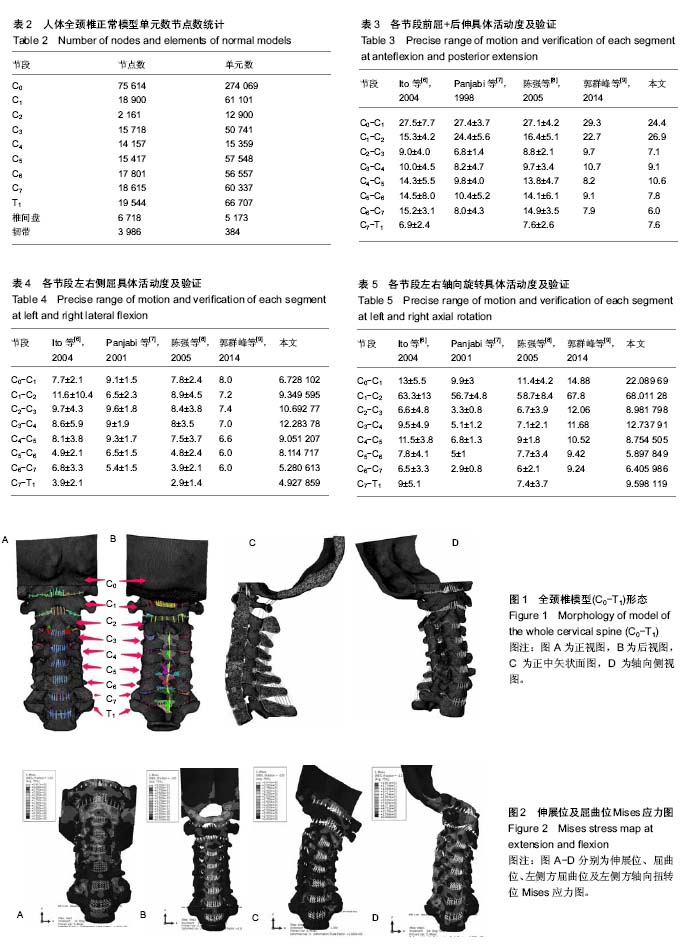| [1] Yoganandan N, Kumaresan S, Voo L, et al. Finite element application in human cervical spine modeling. Spine. 1996; 21(15):1824-1834. [2] Zhang QH, Teo EC, Ng HW, et al. Finite element analysis of moment-rotation relationships for human cervical spine. J Biomech. 2006;39:189-193.[3] Shirazi-Adl A, Ahmed AM, Shrivastava SC, et al. Mechanical response of a lumbar motion segment in axial torque alone and combined with compression. Spine. 1986;11(9):914-927.[4] Schmidt H, Heuer F, Drumm J, et al. Application of a calibration method provides more realistic results for a finite element model of a lumbar spinal segment. Clin biomech. 2007;22(4):377-384.[5] Schmidt H, Kettler A, Heuer F, et al. Intradiscal pressure, shear strain, and fiber strain in the intervertebral disc under combined loading. Spine. 2007;32(7):748-755. [6] Ito S, Ivancic PC, Panjabi MM, et al. Soft tissue injury threshold during simulated whiplash: a biomechanical investigation. Spine. 2004;29(9):979-987.[7] Panjabi MM, Crisco JJ, Vasavada A, et al. Mechanical properties of the human cervical spine as shown by three-dimensional load-displacement curves. Spine. 2001; 26(24):2692-2700.[8] 陈强.挥鞭样损伤的生物力学和临床研究[J].第二军医大学学报, 2005,12(3):631-635.[9] 郭群峰,陈方经,倪斌,等.带有颅底的全颈椎三维有限元模型的建立及分析[J].中国脊柱脊髓杂志,2014,24(6):550-554. [10] Panjabi MM. Cervical spine models for biomechanical research. Spine. 1998;23(24):2684-2699.[11] Schmidt H, Galbusera F, Rohlmann A, et al. What have we learned from finite element model studies of lumbar intervertebral discs in the past four decades? J Biomech. 2013;46(14):2342-2355.[12] Coffee MS, Edwards WT, Hayes WC, et al. Biomechanical properties and strength of the human cervical spine. Transactions of ASME Bioengineering Division. 1987;3:71-72.[13] Goel VK, Clausen JD. Prediction of load sharing among spinal components of a C5-C6 motion segment using finite element approach. Spine, 1998;23(6):684-691.[14] Teo EC, Ng HW. Evaluation of the role of ligaments, facets and disc nucleus in lower cervical spine under compression and sagittal moments using finite element method. Med Eng Phys. 2001;23:155-164.[15] Del Palomar AP, Calvo B, Doblare M. An accurate finite element model of the cervical spine under quasi-static loading. J Biomech. 2008;41:523-531.[16] Kallemeyn N, Gandhi A, Kode S, et al. Validation of a C2-C7 cervical spine finite element model using specimen-specific flexibility data. Med Eng Phys. 2010;32:482-489.[17] Panzer BM, Fice BJ, Cronin SD.Cervical spine response in frontal crash. Med Eng Phys. 2011;33:1147-1159.[18] Womack W, Leahy PD, Patel VV, et al. Finite element modeling of kinematic and laod transmission alterations due to cervical intervertebral disc replacement. Spine. 2011;36(17): E1126-E1133.[19] 王辉昊,詹红生,陈博,等.正常人全颈椎(C0-T1)三维有限元模型的建立与验证[J].生物医学工程学杂志,2014,31(6):1243-1248.[20] Erbulut DU, Zafarparandeh I, Lazoglu I, et al. Application of an asymmetric finite element model of the C2-T1 cervical spine for evaluating the role of soft tissues in stability. Med Eng Phys. 2014;36(7):915-921. [21] Yoganandan N, Kumaresan S, Pintar FA, et al. Biomechanics of the cervical spine. Part 2: Cervical spine soft tissue responses and biomechanical modeling. Clin Biomech. 2001; 16:1-27.[22] Ha SK, et al. Finite element modeling of multi-level cervical spinal segments (C3-C6) and biomechanical analysis of an elastomer-type prosthetic disc. Med Eng Phys. 2006;28: 534-541.[23] 苏再发,贾连顺,张美超,等.利用Mimics和Freeform建立下颈椎三维非线性有限元模型[J].脊柱外科杂志,2009,7(4):221-225.[24] Zafarparandeh I, Lazoglu I. Application of the finite element method in spinal implant design and manufacture.. The design and manufacture of medical devices. Woodhead Publishing. 2012.[25] 席焱海,叶晓健,何海龙.下颈椎双侧关节突交锁三维有限元模型的建立和验证[J].中华医学杂志,2014,94(1):47-50.[26] 李斌,赵文志,陈秉智.有限元分析:椎间盘退变对颈椎生物力学的影响[J].中国组织工程研究,2017,21(11):1748-1752.[27] O’reilly MA, Whyne CM. Comparison of computed tomography based parametric and patient-specific finite element models of the healthy and metastatic spine using a mesh-morphing algorithm. Spine. 2008;33(17):1876-1881.[28] Ganbat D, Kim K, Jin YJ, et al. Heterotopic ossification in cervical total disk replacement: a finite element analysis. Proc Inst Mech Eng H. 2014;228(2):200-205.[29] Ganbat D, Kim YH, Kim K, et al. Effect of mechanical loading on heterotopic ossification in cervical total disc replacement:a three-dimensional finite element analysis. Biomech Model Mech. 2016;15(5):1191-1199.[30] 陈建清,赵刘军,祁峰,等.颈椎两节段椎体次全切后前路椎弓根螺钉固定的生物力学有限元研究[J].中华实验外科杂志, 2016, 33(4):1067-1071. |
.jpg)

.jpg)
.jpg)